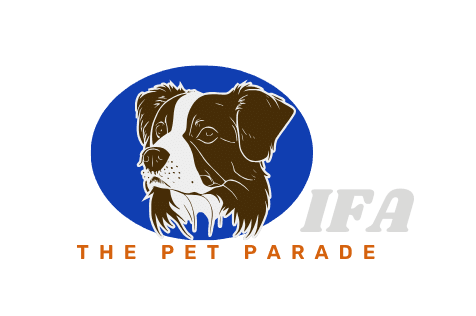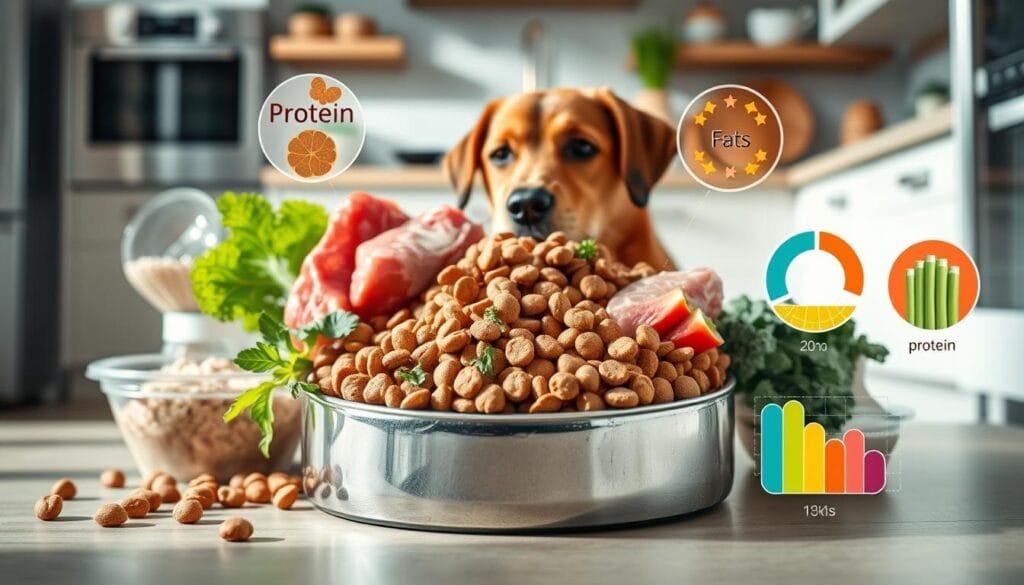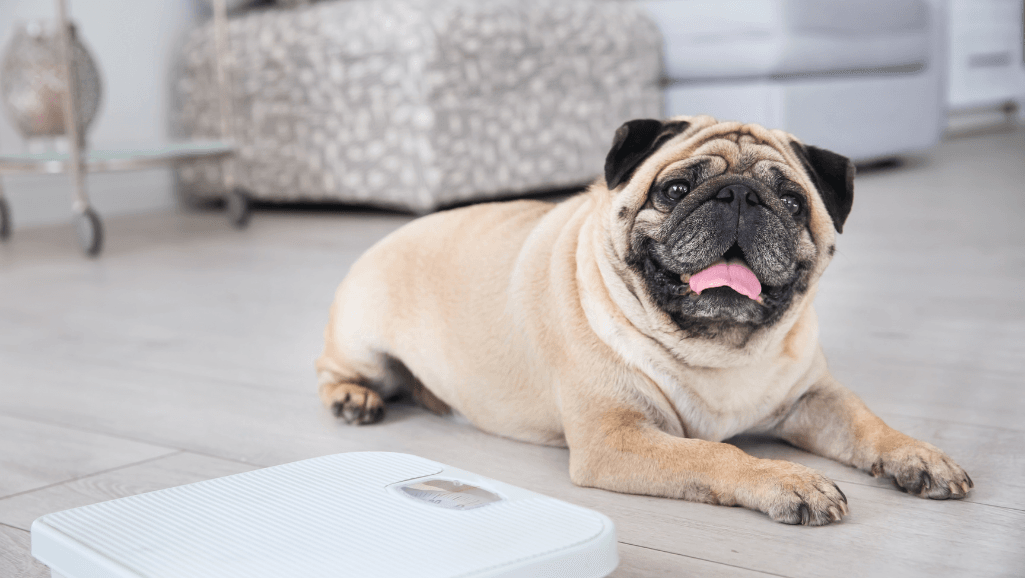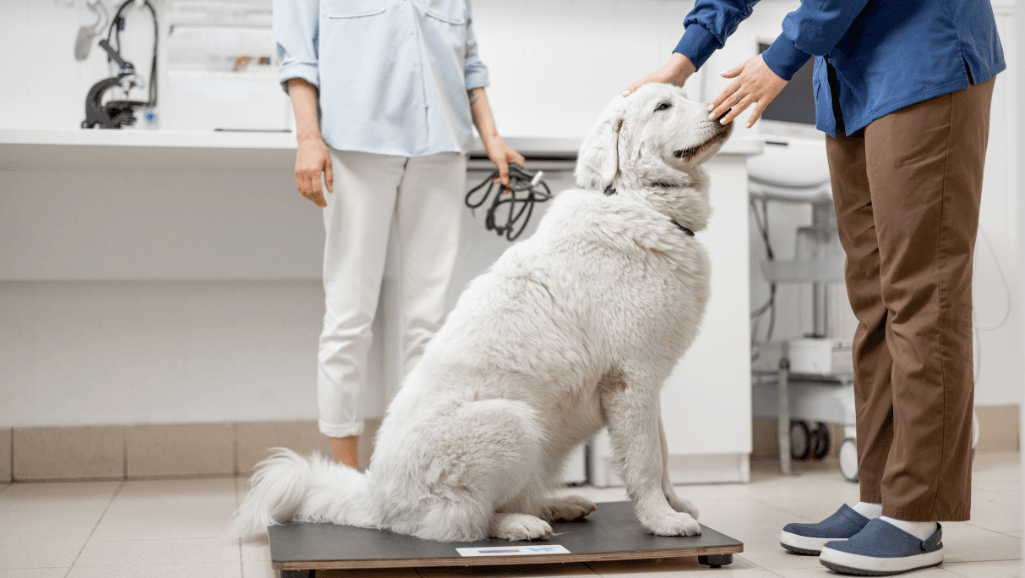We all want the best for our furry friends, and keeping them at a healthy weight is key. With over half of dogs in the U.S. being overweight, it’s vital to pick the right weight management dry food for dogs. This guide will show you how to choose the best food for your dog’s health and happiness.
Obesity in dogs can cause serious health problems like osteoarthritis and heart disease. By picking the right food and keeping them active, you can help your dog stay healthy. This could even add up to 2.5 years to their life.
We’ll talk about why weight management is important for dogs. We’ll also cover how to pick the best dry food and review top brands. You’ll learn about portion control, exercise, and myths about dog weight management. This will help you make the best choices for your pet’s health.
Key Takeaways
- Best Weight Management Dry Food for Dogs Guide 2025.
- More than half of dogs in the U.S. are overweight or obese, which can lead to serious health issues
- Choosing the right weight management dry food is vital for a healthy weight in dogs
- Low-calorie dog kibble and reduced-fat meals help dogs lose weight safely
- Proper portion control, feeding guidelines, and exercise are key for weight management
- Regular vet visits and tracking your dog’s progress are essential for long-term success
Understanding Weight Management in Dogs
As a dog owner, keeping your pet at a healthy weight for dogs is key. Overweight dogs face many health risks. These risks can shorten their life and make them less happy. By using good canine weight management methods, you can help your dog stay healthy and avoid obesity problems.
Importance of Maintaining a Healthy Weight
Keeping your dog at a healthy weight is vital for their health. Research shows that dogs at a normal weight live up to 2.5 years longer than overweight ones. A healthy weight means a happier, longer, and more active life for your dog.
Common Health Risks of Overweight Dogs
Overweight dog health risks are many and serious. They can greatly affect your dog’s life quality. Some common risks include:
- Osteoarthritis and joint injuries
- High blood pressure
- Type 2 diabetes
- Heart disease
- Kidney disease
- Bladder issues
- Liver disease
Keeping your dog at a healthy weight can lower these risks.
Signs Your Dog May Need Weight Management
Knowing the signs of obesity in dogs is important. This way, you can help your dog stay healthy. Signs that your dog might need weight management include:
- Difficulty feeling their ribs or spine
- Lack of a visible waist
- Excess fat around the neck and base of the tail
- Decreased energy levels and playfulness
- Difficulty breathing or moving around
If you see these signs, it’s time to talk to your vet. They can help create a canine weight management plan for your dog.
Dogs who are a healthy weight live significantly longer than dogs who are overweight.
Criteria for Choosing Weight Management Dog Food
When picking a weight management dog food, look for ingredients that help with healthy weight loss. High-protein, low-carb foods are often recommended by vets. They help keep muscle mass while reducing fat. These foods usually have quality proteins like chicken, lamb, or fish, and fewer carbs.
Calorie control is key when choosing weight management dog food. Look for foods that show calorie content per serving. This makes it easier to keep track of your dog’s daily calories. The Association for Pet Obesity Prevention (APOP) says about 59% of U.S. dogs are overweight or obese. This shows how important portion control and calorie management are.
Analyzing Ingredients for Nutritional Value
When checking out weight management dog food, choose foods with high-quality proteins. Look for lean meats or fish to help keep muscle during weight loss. Avoid foods with too many fillers or by-products, as they offer little nutrition and can lead to weight gain.
Instead, pick foods with nutrient-dense ingredients like fruits, vegetables, and whole grains. These provide important vitamins, minerals, and fiber.
Understanding Caloric Content and Serving Size
Check the caloric content and serving size on the food labels. Aim for a 1-2% body weight loss per week. For healthy dogs, the goal is to lose no more than 2% of their initial body weight weekly.
Vets suggest calculating calories based on your dog’s weight, breed, and activity level. This helps figure out their daily calorie needs for weight loss.
The Role of Fiber in Weight Management
Fiber is important in weight loss dog food. It helps you feel full and satisfied. Ingredients like peas, sweet potatoes, and beet pulp can reduce calorie intake while keeping digestion healthy.
But, too much fiber can cause stomach problems. Talk to your vet to find the right amount of fiber for your dog.
Top Brands for Weight Management Dry Dog Food
Choosing the right weight management dry dog food is key for your furry friend’s health. With many options, picking the best can be tough. Let’s explore top brands vet-recommended for weight control.
Royal Canin: Tailored Nutrition for Different Breeds
Royal Canin offers formulas for various breeds’ needs. Their Satiety Support wet food helps dogs lose weight safely. 97% of dogs lost weight in three months in trials.
Their Hydrolyzed Protein Moderate Calorie Dog Food is great for dogs with sensitivities and weight issues. It’s packed with amino acids, B vitamins, and Omega-3 fatty acids.
Hill’s Science Diet: Vet-Recommended Options
Hill’s Science Diet is a vet favorite for weight control dog food. Their Perfect Weight Dog Food leads to 70% of dogs losing weight in 10 weeks. Their r/d Dog Food supports healthy weight loss and maintenance.
Their Prescription Diet Metabolic Weight Management Dog Food is a hit. It has a 96% success rate in two months for weight loss.
Purina Pro Plan: High Protein and Low Fat
Purina Pro Plan has reduced-fat formulas with lots of protein. This helps dogs keep lean muscle while losing weight. Their Weight Management Adult Dry Dog Food has 15% less fat than regular formulas.
Purina Pro Plan Veterinary Diets OM Overweight Management Dog Food is even better. It includes soy isoflavones that reduce weight gain by 50% compared to other diets.
“Choosing the right weight management dog food can make all the difference in your pet’s health and quality of life. By opting for trusted brands like Royal Canin, Hill’s Science Diet, and Purina Pro Plan, you can feel confident that you’re providing your dog with the nutrition they need to achieve and maintain a healthy weight.”
Reviewing the Best Dry Dog Foods for Weight Management
Choosing the right dry dog food is key for your dog’s health. With many options, picking the best can be tough. We’ll look at top dry dog foods for weight management. We’ll focus on low-calorie foods, grain-free vs. grain-inclusive, and natural ingredients for healthy weight loss.
Low-Calorie Options for Weight Control
Caloric content is important in weight management dog food. Look for foods with fewer calories to help your dog feel full. About 59 percent of dogs are overweight or obese, leading to health issues like diabetes and heart disease. Low-calorie weight loss dog food options, such as Hill’s Science Diet Perfect Weight, are great for controlling weight.
Grain-Free vs. Grain-Inclusive Formulas
Choosing between grain-free and grain-inclusive dog food is important. Grains like barley and rice offer health benefits. Grain-free weight management dog food is good for dogs with sensitivities. Always talk to your vet to find the best food for your dog.
“Dry dog food should contain about 27% protein and around 16% fat to support energy needs and muscle maintenance while limiting weight gain.” – Dr. Lisa M. Freeman, DVM, PhD, DACVN
Natural Ingredients for Healthier Choices
Choose weight management dog food with natural ingredients for healthy weight loss in dogs. Look for high-quality protein sources like chicken and fish. Blue Buffalo Life Protection Formula Healthy Weight uses real chicken as its main ingredient. Foods like Hill’s Science Diet Perfect Weight are also good for weight loss.
The best weight management food has consistent protein and moderate fat. By picking a high-quality, low-calorie dog food, you can help your dog stay healthy. This will make your dog’s life longer and happier.
How to Transition Your Dog to Weight Management Food
Switching your dog to a weight loss diet is a big step towards a healthier life. It needs patience, care, and attention for a smooth transition. Start by mixing a little of the new food with their old food. Gradually add more new food over 5-7 days.
This slow change helps your dog’s stomach get used to the new food. Dogs with sensitive stomachs might need a longer time. Watch your pet closely and adjust the pace if needed.
Monitoring Your Dog’s Response to the New Food
Keep an eye on how your dog reacts to the new food. Look for signs like vomiting, diarrhea, or not wanting to eat. Use a Fecal Scoring Chart to check their digestive health. Aim for a score of 3-4.
If your dog shows bad reactions or keeps having digestive problems, talk to your vet. They can check for food allergies or intolerances.
Importance of Veterinary Guidance
Getting advice from your vet is key when changing your dog’s food. They can give you tips based on your dog’s health, age, and breed. They can also help pick the best food for your pet’s needs.
“No one diet is universally ‘best’ for every dog due to individual variations in age, health, and preferences.” – World Small Animal Veterinary Association
For your dog to lose weight successfully, you need the right food, the right amount, and exercise. Work with your vet and watch your dog’s progress. This way, you can help them stay healthy and happy for a long time.
Balancing Nutrition and Weight Loss
Choosing the right weight management dog food is key. It must balance macronutrients and micronutrients for your dog’s health. Talking to your vet is a great way to pick the best diet for your dog.
The Importance of Macronutrients
Macronutrients are vital for keeping your dog’s muscles strong and helping them lose weight. Look for foods with:
- High protein to keep muscles strong
- Less fat to cut down on calories
- Controlled carbs for steady energy
Hill’s Science Diet Perfect Weight Adult Dog Food is a top pick. It has lots of protein and fiber, making dogs feel full. L-carnitine helps turn fat into energy, which is great for weight control.
Micronutrients: Essential Vitamins and Minerals
Essential vitamins and minerals are also important for your dog’s health while losing weight. A good weight management dog food should have:
- Vitamin A for eyes and immune system
- B vitamins for energy and nerves
- Vitamin D for bones and calcium
- Vitamin E as an antioxidant
- Minerals like calcium, phosphorus, and potassium for bones and body functions
Purina Pro Plan’s Weight Management Formula is also a favorite. It offers a mix of nutrients for healthy weight loss and meets your dog’s nutritional needs.
Steering Clear of Filler Ingredients
When picking a weight management dog food, avoid fillers that don’t offer much nutrition. They can add extra calories and slow down weight loss. Watch out for:
- Corn and wheat gluten
- Soy
- Artificial colors and flavors
- Preservatives
“Blue Buffalo Homestyle Recipe Healthy Weight wet dog food is appreciated for its high protein content, containing real chicken as the primary ingredient and being free of by-product meals, artificial flavors, preservatives, corn, wheat, or soy.”
Choosing a dog food with quality ingredients and avoiding fillers helps your dog stay healthy and at a good weight.
Portion Control and Feeding Guidelines
Getting the right amount of food is key for a dog’s health. Too much food can make dogs overweight, which is a big problem. It’s important to know how much food your dog needs based on their weight and the food’s calorie count.
Adult dogs need between ½ to 4⅔ cups of dry food each day, depending on their size. Puppies eat more, from ½ to 5¾ cups daily. Senior dogs might need 1 to 4 ¾ cups, based on their weight.
When deciding how much to feed, consider your dog’s age, size, how active they are, and their body condition. These factors help determine their nutritional needs.
Benefits of Scheduled Feeding vs. Free Feeding
Scheduled feeding helps control how much your dog eats, unlike free feeding. Most dogs do well with 2-3 meals a day. This way, you can watch their appetite and prevent overeating.
Some dogs can eat whenever they want without getting too fat. But, most dogs do better with a set meal schedule. Vets usually suggest two meals a day for adults and more for puppies. Small dogs and puppies might need to eat more often to keep their blood sugar stable.
Remember, treats should not make up more than 10% of your dog’s total calories.
Using Measuring Tools for Accuracy
To measure dog food accurately, use cups or a food scale. The right amount depends on your dog’s weight:
- 3 to 6 lbs.: ⅓ to ½ cup per serving
- 10 to 20 lbs.: ¾ to 1 ⅓ cups per serving
- 30 to 50 lbs.: 1 ¾ to 2 ⅔ cups per serving
- 60 to 100 lbs.: 3 to 4 ½ cups per serving
- Over 100 lbs.: 4 ½ cups + ¼ cup for every additional 10 lbs.
By following these guidelines and using measuring tools, you can keep your dog at a healthy weight. This prevents obesity-related health problems. Always talk to your vet for advice on what’s best for your dog.
Enhancing Weight Management with Exercise
Exercise is key for overweight dogs to lose weight and stay healthy. It burns calories and keeps them mentally sharp. Plus, it strengthens the bond between you and your dog.
Recommended Exercise Routines for Overweight Dogs
Start with gentle activities for overweight dogs. Slowly add more intensity and time as they get fitter. Good exercises include:
- Short, frequent walks around the neighborhood
- Swimming or hydrotherapy, which is gentle on joints
- Fetch games with soft toys or balls
- Obstacle courses or agility training
“Exercise for overweight dogs should be tailored to their individual needs and abilities. Always consult with your veterinarian before starting a new exercise program.”
Benefits of Interactive Play Time
Interactive play is great for physical and mental health. It keeps your dog active and entertained. It also helps with weight loss. Interactive play benefits include:
- Burning calories and increasing overall activity levels
- Reducing boredom and destructive behaviors
- Strengthening the human-animal bond
- Improving your dog’s problem-solving skills
Incorporating Regular Walks into Your Routine
Walking is a key part of helping your dog lose weight. Aim for two walks a day. Start short and gradually increase the length and intensity. Remember to:
- Start with short, frequent walks and build up slowly
- Choose comfortable, supportive walking gear for your dog
- Vary your walking routes to provide mental stimulation
- Be mindful of your dog’s energy levels and adjust
By mixing low-impact exercises, interactive play, and regular walks, you support your dog’s weight loss. It also strengthens your bond and improves their life quality.
Tracking Your Dog’s Progress
Keeping your dog on the path to a healthy weight is key. By monitoring and tracking, you can help them reach their goals. Celebrate their successes to keep them motivated.
Keeping a Weight Management Journal
A weight management journal is a great tool. It helps track your dog’s food, exercise, and weight. Update it regularly with their progress and any health changes.
Regular Weigh-Ins and Adjustments
Regular weigh-ins with your vet are important. Aim for a 3-5% weight loss each month. If progress is slow, your vet may suggest diet or exercise changes.
“Slow and steady wins the race when it comes to dog weight loss. Celebrate each milestone, no matter how small, to keep you and your pup motivated.”
Recognizing Milestones and Celebrating Progress
Celebrate your dog’s weight loss milestones. Notice improvements in their energy and health. Reward them with playtime, a new toy, or a healthy treat.
Tracking progress, regular weigh-ins, and celebrating milestones help your dog stay healthy. This leads to a happier, longer life for them.
Common Myths About Dog Weight Management
Managing your dog’s weight requires knowing the truth. Many myths can mislead pet owners. Understanding these myths helps you make better choices for your dog’s health.
Debunking Dietary Myths
Some think all grains are bad for dogs. But, most dogs benefit from whole grains. Another myth is that homemade diets are always better. It’s key to work with a vet to ensure a balanced diet.
“Diet” and “lite” dog foods often have too much fiber and carbs. This can lead to weight gain and food intolerances. Choose foods with high-quality protein, healthy fats, and essential nutrients.
Understanding Exercise Misconceptions
Exercise is vital for dog weight management. But, it’s important to do it right. Over-exercising can harm your dog’s joints. Aim for regular, moderate exercise that suits your dog’s needs.
Exercise alone isn’t enough for weight loss. You also need to control portions and eat a balanced diet. Losing weight takes time and consistency.
Importance of Professional Advice
Getting advice from your vet is essential for your dog’s weight management. They can give you personalized tips on diet, exercise, and health. Your vet knows what’s best for your dog.
“Your veterinarian is your best resource for accurate information and guidance on your dog’s weight management. Don’t hesitate to ask questions and seek their expertise throughout the process.”
Working with your vet helps you create a safe, effective weight management plan. Remember, every dog is different. Stay informed, be patient, and celebrate small victories.
Maintaining Long-Term Weight Management
Getting your dog to a healthy weight is a big achievement. But, it’s just the start. Keeping your dog at a healthy weight is key to their long-term health. With the right plan and habits, your dog can stay at their ideal weight and live a happy, active life.
Transitioning to Maintenance Dog Food
When your dog reaches their target weight, it’s time for a new diet. Switching to maintenance food should be done slowly to avoid stomach problems. Choose a food that’s balanced and has the right amount of calories. Talk to your vet to find the best maintenance food for your dog.
Establishing Lifelong Healthy Habits
Keeping a healthy weight is a lifelong journey. Here are some important habits to keep:
- Portion control: Measure your dog’s food to ensure they receive the appropriate amount based on their size and activity level.
- Regular exercise: Engage your dog in daily physical activities, such as walks, runs, or play sessions, to keep them active and burn calories.
- Limiting treats: Treats should make up no more than 10% of your dog’s daily calorie intake. Opt for low-calorie, nutrient-dense options.
“Weight loss for dogs is 60-70% diet and 30-40% exercise.” – Association for Pet Obesity Prevention (APOP)
Regular Check-Ups with Your Veterinarian
Regular vet visits are key to keeping an eye on your dog’s weight and health. Your vet can check your dog’s body condition, adjust their diet or exercise, and address health issues. Try to visit your vet at least once or twice a year, or more often if they suggest it.
Long-term weight management for dogs is a team effort. By working with your vet, sticking to healthy habits, and showing your dog love and support, you can help them stay healthy. This way, your dog can live a long, happy life with you.
Conclusion: Sustaining Healthy Weight for Dogs
Keeping your dog at a healthy weight is key for their happiness and health. Dogs at the right weight can live up to 1.8 years longer. Excess weight can cause many health problems, like arthritis and diabetes.
By using good weight management strategies, you can help your dog stay healthy. This means a happier, more active life for them.
Recap of Key Points in Weight Management
Successful weight management for dogs involves several steps. First, choose a high-quality dog food that fits your pet’s needs. Use measuring tools to control portions and limit treats.
Regular exercise, like walks and play, helps with weight loss and strengthens your bond. Regular weigh-ins and adjustments keep your dog on track to a healthy weight.
Encouraging a Balanced Lifestyle for Your Dog
A balanced lifestyle is essential for your dog’s health. This means a nutritious diet, regular exercise, and mental stimulation. A consistent routine helps maintain healthy habits.
Regular vet visits are important for monitoring your dog’s weight and health. Your vet can offer personalized advice on diet and exercise.
Resources for Ongoing Support and Guidance
There are many resources to help manage your dog’s weight. Talk to your vet for advice specific to your dog. Many pet food brands offer weight management formulas and guidelines.
Online resources and pet health websites offer valuable tips. Joining dog-walking groups or fitness classes can motivate you and your dog.





















